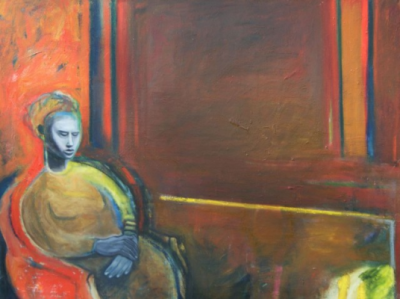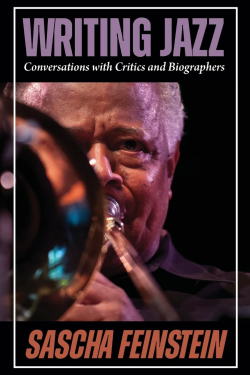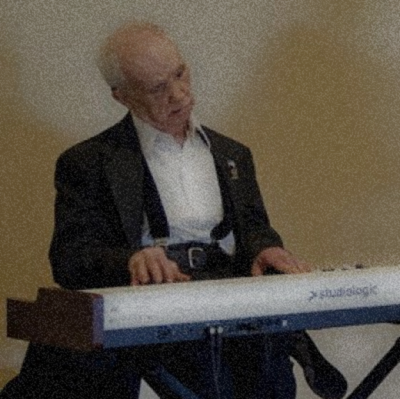.
.

“Red Meditation” by James Brewer
.
___
.
…..In recent days, I have posed this question via email to a handful of creative artists and citizens of note:
.
…..“During this time of social distancing and isolation at home, what are examples of the music you are listening to, the books you are reading, and/or the television or films you are viewing?” (If you wish, please feel free to also share your thoughts on the effects this isolation is having on your creativity or on your world).
.
…..Responses to this question will be published periodically as this era progresses.
.
This edition features the email response of Arizona State University professor and author Tracy Fessenden
(published with only minor stylistic editing)
.
.
___
.
.

Steve and Margaret Forster Professor, Arizona State University; author of Religion Around Billie Holiday
.
___
.
This response was submitted on May 4
.
…..I made a few years ago a playlist of songs for a book I was writing about Billie Holiday. My habit became to play it whenever I visited some new place, because it helped dispel the strangeness, and made me feel at home. Now that I am at home, with almost everyone else in the world, I find it returns those places to me, and makes me feel much less alone. I’ve long appreciated poet Michael Robbins’s explanation, in an essay that feels especially brilliant and acute these days, of why this should be so. Popular songs, writes Robbins—and Holiday was a gorgeous interpreter of them—“depend on the possibility of communal participation” for their full effect; they ground “us in a community, however attenuated or virtual.” The songs we know by heart bring us into the company of everyone else who knows them, too. I have heard of family members sending playlists for those they are barred from being with in nursing homes and hospitals,.and of healthcare workers cradling plastic-wrapped phones to the ears of the sick and dying, to bring them songs their loved ones wanted them to hear.
…..The last trip I took before the pandemic kept us home was to my parents’ house in Massachusetts. My mother died late last spring, not long after my father, both of them blessedly in the company of family at the end. My brothers and I met to sort through their things and take some keepsakes home with us. I ended up “taking” some of their favorite records, not the long-since discarded vinyl, but downloads of albums I’d listened to them play over and over: Janis Joplin’s Pearl, The Mamas and the Papas, Abbey Road, the soundtracks from The Graduate and Hair. I have a playlist now that sounds like the parties I stayed awake at night straining to hear, the music and the ice-tinkling laughs, and it makes my 30-something parents and their 30-something friends shimmeringly present to me in all their sweet, goofy, Pucci-caftan-wearing, 1970s glory.
…..I’ve just about finished the spring semester of teaching, and a shout-out here to students and faculty everywhere who’ve managed to do this on Zoom. I find being on Zoom awkward and glitchy and draining, and am grateful that it lets us be awkward and glitchy and drained together, which feels as much as anything like being in the moment. I taught a class on religion and popular culture, and assigned a bunch of movies that students reported sat well with their quarantine lives: Monty Python’s Life of Brian, the 1927 Jazz Singer, The Godfather, The Exorcist, Spike Lee’s Malcolm X, and Kumaré, which was filmed largely in Arizona, where I teach. My university is making tentative plans to reopen in the fall, and my expectation is that trying to make anything work in the classroom while wearing face masks and standing six feet apart is likely to send us straight back to the weird techno-intimacy of Zoom. In any case, when I teach the class again I’ll put more of a focus on religion and American popular sound, with help from great writing like Joshua Guthman’s Strangers Below, David Lehman’s A Fine Romance, Gayle Wald’s Shout, Sister, Shout!, Adam Gussow’sBeyond the Crossroads, and Peter Coviello’s question for the ages, “Is There God After Prince?”, which is not yet a book, but promises to be one, soon.
…..In April I reread a favorite, M.F.K. Fisher’s Long Ago in France: The Years in Dijon, the same week I watched all of Season 3 of Babylon Berlin. It made an auspicious pairing: each a sumptuous, clear-eyed lookback to the year 1929, with Europe hurtling headlong into nightmares just beyond their characters’ line of sight or fathoming. In this regard, the book I’m reading now, poet H.L. Hix’s American Anger, feels terrifying and miraculous. It was in fact published in early 2016, but it reads as though it were a missive from the future, a blistering retrospective account of America just before the last presidential election. In a remarkable series of interlocking poems, American Anger reveals the springs and motors that would drive us inexorably to the place we find ourselves now: an America where demonstrators wielding assault weapons and Confederate and Nazi symbols storm government buildings to demand an end to public health measures in a pandemic, and are not arrested as terrorists, but instead praised by the president as “very good people.”
…..Hix calls American Anger “an evidentiary.” Many universities, including mine, are collating evidentiaries of the plague year, archiving for future historians the ephemera that will document the way we live now. American Anger predicted the problem of not being able to put boundaries on such a collection, of there being nothing, now, anywhere, that lies outside of the present pandemic and our heroic and murderously inept responses to it. “Put another way,” Hix writes in an afterword to American Anger, “where evidence is limited or scant or elusive, it is susceptible to being marshalled, subjected to my ends, as in a court case. (If the glove doesn’t fit, you must acquit.) Where evidence is unlimited, though, where there is more evidence than could possibly be gathered or relayed, where the evidence is there for all to see, the power relation is inverted: I do not marshal, but instead am marshalled by, the evidence.”
…..A friend tells me that in quarantine we are becoming more ourselves. Another reminds me that when Pope Francis speaks these days of apocalypse he means it not in the sense of world-ending, though we may come to that, but of unveiling, of bringing to light what is hidden. The Covid-19 pandemic feels apocalyptic in just this sense: in Hix’s words, it reveals “as evidence the evidence all around us, including and especially the evidence we ourselves are.”
.
.
___
.
.
Listen to the 1937 recording of Billie Holiday singing “Trav’lin All Alone” (with Lester Young on saxophone, Buck Clayton on trumpet, Jo Jones on drums, Freddie Green on guitar, Claude Thornhill on piano, and Buster Bailey on clarinet)
.
.
.
.
Click here to read Volume 1 of this series, featuring recording artist Bruce Cockburn.
Click here to read Volume 2 of this series, featuring music writers/critics Howard Mandel and Joel Selvin
Click here to read Volume 3 of this series, featuring journalist Joe Hagan and photographer Tim Davis
Click here to read Volume 4 of this series, featuring Spelman College president Mary Schmidt Campbell
.
Click here to read the Jerry Jazz Musician roundtable conversation, “Religion ‘around’ Langston Hughes, Billie Holiday and Ralph Ellison” with authors Tracy Fessenden, Wallace Best and M. Cooper Harriss
.
.








































